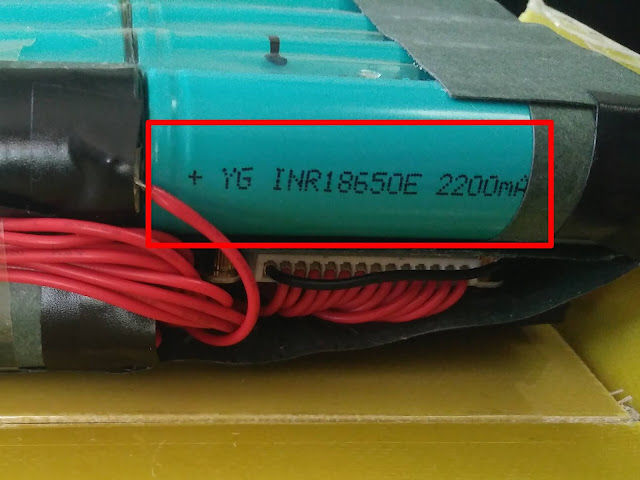I do try to say that whatever the retailers claim (and you believe used car salesmen too?) as its sealed in a shrinkwrapped pack you just won't fucking know unless you strip it back (probably voiding warranty) and look for yourself. I'd say almost none of the vocal Wangers ever do this.
While I was doing my various stages of repairing my 500W single motor battery pack I posted (in here) that I had found what I think was the cells used in my pack.
From this blog post I wrote:
this makes me wonder if this is the newer chemistry with Nickel in it?
INR - NMC - Lithium manganese nickel
The reigning champ of the 18650 vaping world. This chemistry adds nickel to the IMR chemistry above, making it a "hybrid" chemistry. It combines the safety and low resistance of manganese and the high energy of nickel.The resulting battery chemistry gives you a reasonably high capacity and a high discharge current. Importantly for vapers, the chemistry is very stable, meaning that you don't need expensive built-in protective circuits.
There is extensive innovation within this chemistry as well. Sony, Samsung, and LG are all developing next-gen INR batteries with different ratios of manganese, nickel, and cobalt.
which when I examine this in context of the earlier mentioned blog post it becomes very informative.
Also, a little web searching revealed this test on what appears to be the same batteries. I think its reasonable to believe that they are more or less the same as the cells that are in my pack. His conclusion was:
Conclusion
The cells looks fairly good, they are obvious not for 30A, but 20A looks fine.
So that site (lygte-info.dk) has that excellent tool for making comparisons. Since I can't share such a link here's a screen grab of the Parkside battery beside the ("Famous") LG branded one.
Now I actually used that image for a different discussion (I'm into reuse) and the red line from 3.5V shows the point where its performing under load (riding along, probably up a mild hill) a little while into your ride. Now I notice many people seem to have forgotten how to read graphs (so pardon me spoon feeding here) but the LG battery falls to the same voltage as the Parkside does nearly half an amp hour sooner.
Now that's per cell, and recall that our batteries are composed of many cells in bundles (please see this post for details) and strings, however what matters here is the P bundles for the Amps. We often have 4 (or even more) cells in this bundle. So for each cell to be needing 3A with 4 cells that would mean you'd be pulling 12A out of the pack (3 x 4 = 12 right?) which is entirely possible with (say) a 500W single motor scooter (usually 1000W motors have bigger P in their battery config).
So in the above the Parkside delivers better Volts well into the ride with less of a slow down (remember V = speed) until just before failure.
Pretty good isn't it. Even better my observations (and calculations) have shown that my own yield from my Mercane battery pack is pretty consistent with the better red curve of the Parkside. Further the only other thing is how many cycles you may get, and I can say that after nearly a year of frequent riding I find no observable (based on distance, speeds and GPS data) degradation in my battery pack.
Case in point, I was riding it around yesterday (well and the day before) and had done over 20km (some of that on ludicrous mode and pushing full speed on down hills) and observed on the way home that the voltage was buckling down to about 44.5V suggesting to me that it was time to recharge. Now even though the voltage popped back up to 47.x when stopped, don't be fooled, that's not how batteries are measured for discharge. So I put my 150A inline and recharged. It took 8.61Ah to charge. Looking at the curve from the site at lytge-info and applying my numbers we see this:
- approximate discharge based on observed voltage was 10.5Ah
- my recharge was actually 8.6Ah
- given the above cell is 2000mAh not the 2200mAh my cells are this more or less accounts for the difference and
- given that I was discharging at an unknown rate (probably higher than 6A understanding the Watts required for the speeds) it works out about right
Not bad for a pack that has had at least 100 cycles of 100% recharge (if like that even matters compared to other factors)
So play with that comparitor tool and check out some batteries, go price them and then decide if what you have is a sufficient cost benefit for you. After all some people want to balance how much they spend... looking at the discharge curves, frankly I'm glad I don't have LG cells and instead have money in my pocket. A year later and evidence shows there's nothing wrong with what was in the scooter.














No comments:
Post a Comment